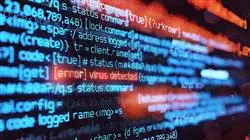University certificate
The world's largest faculty of information technology”
Introduction to the Program
The most complete tour through the dangers and vulnerabilities of mobile devices and their cyber protection"

Home and business security needs to be structured in layers, it is like a chain and will only be as strong as the weakest link in the chain. This Postgraduate diploma presents the main threats to users' computers and servers so that we are able to take the appropriate measures and be alert to any situation.
The more new functionalities there are and the more we communicate with each other, the more our attack surface increases. In other words, the possibilities and ways for cybercriminals to achieve their goals are growing. That is why security defense and monitoring systems must evolve as well. Because in a world where teleworking and Cloud services are becoming more and more common, a traditional perimeter firewall is not enough. For this reason, this Postgraduate diploma will also address the importance of designing a multi-layer defence, also known as “Defence in Depth” covering all aspects of a corporate network where some of the concepts and systems that will be discussed can also be used and applied in a domestic environment.
There is no such thing as 100% security, but if you know the types of attacks you face, the risks you are exposed to and have the information you need to deal with them, you have taken an important step and added another layer of security to your information.
Start acting with the broadest knowledge of the types of risks currently existing and the means of defence applicable in each case"
This Postgraduate diploma in Defensive Cybersecurity contains the most complete and up-to-date educational program on the market. The most important features include:
- Practical case studies presented by experts
- The graphic, schematic, and practical contents with which they are created, provide scientific and practical information on the disciplines that are essential for professional practice
- Practical exercises where the self-assessment process can be carried out to improve learning
- Its special emphasis on innovative methodologies in Advanced Practice Nursing
- Theoretical lessons, questions to the expert, debate forums on controversial topics, and individual reflection assignments
- Content that is accessible from any fixed or portable device with an Internet connection
A complete tour that will allow you to know what they are and how current cyber threats work as a basis for developing defensive strategies"
The program’s teaching staff includes professionals from the sector who contribute their work experience to this program, as well as renowned specialists from leading societies and prestigious universities.
The multimedia content, developed with the latest educational technology, will provide the professional with situated and contextual learning, i.e., a simulated environment that will provide immersive specialization programmed to learn in real situations.
This program is designed around Problem-Based Learning, whereby the professional must try to solve the different professional practice situations that arise throughout the program. This will be done with the help of an innovative system of interactive videos made by renowned experts.
With a totally practice-focused approach, this Postgraduate diploma will boost your skills to the level of a specialist"

A highly educational process, created to be affordable and flexible, with the most interesting methodology of online teaching"
Why study at TECH?
TECH is the world’s largest online university. With an impressive catalog of more than 14,000 university programs available in 11 languages, it is positioned as a leader in employability, with a 99% job placement rate. In addition, it relies on an enormous faculty of more than 6,000 professors of the highest international renown.

Study at the world's largest online university and guarantee your professional success. The future starts at TECH”
The world’s best online university according to FORBES
The prestigious Forbes magazine, specialized in business and finance, has highlighted TECH as “the world's best online university” This is what they have recently stated in an article in their digital edition in which they echo the success story of this institution, “thanks to the academic offer it provides, the selection of its teaching staff, and an innovative learning method aimed at educating the professionals of the future”
A revolutionary study method, a cutting-edge faculty and a practical focus: the key to TECH's success.
The most complete study plans on the university scene
TECH offers the most complete study plans on the university scene, with syllabuses that cover fundamental concepts and, at the same time, the main scientific advances in their specific scientific areas. In addition, these programs are continuously being updated to guarantee students the academic vanguard and the most in-demand professional skills. In this way, the university's qualifications provide its graduates with a significant advantage to propel their careers to success.
TECH offers the most comprehensive and intensive study plans on the current university scene.
A world-class teaching staff
TECH's teaching staff is made up of more than 6,000 professors with the highest international recognition. Professors, researchers and top executives of multinational companies, including Isaiah Covington, performance coach of the Boston Celtics; Magda Romanska, principal investigator at Harvard MetaLAB; Ignacio Wistumba, chairman of the department of translational molecular pathology at MD Anderson Cancer Center; and D.W. Pine, creative director of TIME magazine, among others.
Internationally renowned experts, specialized in different branches of Health, Technology, Communication and Business, form part of the TECH faculty.
A unique learning method
TECH is the first university to use Relearning in all its programs. It is the best online learning methodology, accredited with international teaching quality certifications, provided by prestigious educational agencies. In addition, this disruptive educational model is complemented with the “Case Method”, thereby setting up a unique online teaching strategy. Innovative teaching resources are also implemented, including detailed videos, infographics and interactive summaries.
TECH combines Relearning and the Case Method in all its university programs to guarantee excellent theoretical and practical learning, studying whenever and wherever you want.
The world's largest online university
TECH is the world’s largest online university. We are the largest educational institution, with the best and widest online educational catalog, one hundred percent online and covering the vast majority of areas of knowledge. We offer a large selection of our own degrees and accredited online undergraduate and postgraduate degrees. In total, more than 14,000 university degrees, in eleven different languages, make us the largest educational largest in the world.
TECH has the world's most extensive catalog of academic and official programs, available in more than 11 languages.
Google Premier Partner
The American technology giant has awarded TECH the Google Google Premier Partner badge. This award, which is only available to 3% of the world's companies, highlights the efficient, flexible and tailored experience that this university provides to students. The recognition as a Google Premier Partner not only accredits the maximum rigor, performance and investment in TECH's digital infrastructures, but also places this university as one of the world's leading technology companies.
Google has positioned TECH in the top 3% of the world's most important technology companies by awarding it its Google Premier Partner badge.
The official online university of the NBA
TECH is the official online university of the NBA. Thanks to our agreement with the biggest league in basketball, we offer our students exclusive university programs, as well as a wide variety of educational resources focused on the business of the league and other areas of the sports industry. Each program is made up of a uniquely designed syllabus and features exceptional guest hosts: professionals with a distinguished sports background who will offer their expertise on the most relevant topics.
TECH has been selected by the NBA, the world's top basketball league, as its official online university.
The top-rated university by its students
Students have positioned TECH as the world's top-rated university on the main review websites, with a highest rating of 4.9 out of 5, obtained from more than 1,000 reviews. These results consolidate TECH as the benchmark university institution at an international level, reflecting the excellence and positive impact of its educational model.” reflecting the excellence and positive impact of its educational model.”
TECH is the world’s top-rated university by its students.
Leaders in employability
TECH has managed to become the leading university in employability. 99% of its students obtain jobs in the academic field they have studied, within one year of completing any of the university's programs. A similar number achieve immediate career enhancement. All this thanks to a study methodology that bases its effectiveness on the acquisition of practical skills, which are absolutely necessary for professional development.
99% of TECH graduates find a job within a year of completing their studies.
Postgraduate Diploma in Defensive Cybersecurity
The daily use of the Internet has become an essential part of life in the most advanced societies. Citizens use digital tools for various daily tasks, which has led to great advances in business. As a result, hackers have found in the network a new way to act, which endangers virtually all companies. As a result, company managers are obliged to acquire advanced knowledge in order to act defensively against possible attacks and to implement preventive measures to avoid these threats. To meet this need for specialization on the part of business professionals, TECH has designed the Postgraduate Diploma in Defensive Cybersecurity, which will provide you with top-level competencies in this field.
Specialize in Defensive Cybersecurity in just 6 months
Do you want to know the cutting-edge techniques to ensure security and prevent attacks on hosts, networks, smartphones or IoT? You're in luck! The Postgraduate Diploma in Defensive Cybersecurity has been developed to provide you with this very complete knowledge. Its fully online methodology will allow you to study 24 hours a day and from anywhere, with any electronic device with an Internet connection. In addition, the focus on multimedia formats such as video or interactive summary makes learning more attractive and effective. Also, the program is designed by the best experts in the field, who have created a comprehensive curriculum that will provide you with content applicable in real work situations.







